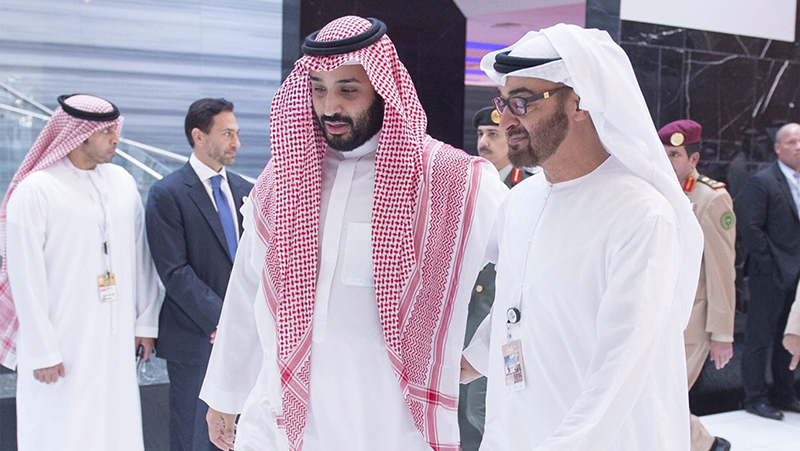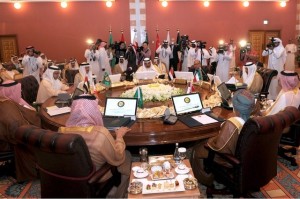by Imad K. Harb
Since the start of the Arab Spring in 2010-2011 and the rise in demands for democratic change in the Arab world, a special relationship has developed between Saudi Arabia and the United Arab Emirates (UAE) that has served several common causes. The two countries helped the return of authoritarianism to Egypt by bankrolling the regime of Egypt’s President Abdel-Fattah el-Sisi after he toppled the former late President Mohamed Morsi in 2013. They started an intervention in Yemen purportedly aimed at restoring its legitimate president, Abdrabbuh Mansour Hadi, to Sanaa. They imposed and now maintain a boycott and blockade of neighboring Qatar after accusing it of plotting against them and weakening joint Gulf Cooperation Council action. They supported and now fund General Khalifa Haftar in his challenge to a United Nations-led political process in Libya. And they claim to be the enforcers of status quo Arab politics in the face of calls for political and other changes in Arab countries.
But now this alliance is experiencing some challenges as the UAE has decided to pull at least part of its military contingent in Yemen out of the country. On the one hand, the Emirati move highlights serious problems in the continuing intervention there, pursued by the UAE and Saudi Arabia since March 2015. On the other hand, it points to differences in how the two countries perceive their four-year joint endeavor, one that they have considered pivotal in preventing a future Iranian sphere of influence in the Arabian Peninsula. These two considerations take on special significance today as the war appears stalemated and the Houthis seem to insist on bringing it to targets in Saudi Arabia itself, both military and civilian, and on occasion to the UAE.
Considerations Surrounding the UAE Move
On July 8, the UAE announced that it is moving to a diplomatic stance from a “military first” strategy in Yemen and is redeploying and reducing troops there. A Yemeni official confirmed the news and said that UAE soldiers fighting Houthi rebels in the western part of the country have “totally vacated” a military base in al-Khokha, which is about 130 kilometers south of the Red Sea city of Hodeida. UAE officials denied that the withdrawal was sudden and affirmed that it had been discussed with Saudi Arabia last year. An Emirati official said the action is not supposed to leave a vacuum because the UAE has trained 90,000 Yemeni tribesmen, former security personnel, and militiamen from the south who could take on the necessary work.
Considering the serious Houthi challenge on the border with Saudi Arabia, the UAE action cannot be a positive development for Saudi Arabia. In fact, Saudi officials are reported to have been disappointed and had “intervened with the Emirati leaders to try to dissuade them from the drawdown.” Failing that, Saudi forces took over command in al-Khokha and the port city of Mokha to its south and sent troops to the southern city of Aden and the adjacent Perim Island in the strategic Bab al-Mandab waterway. The UAE had been instrumental in taking back Aden in 2015 from the Houthi rebels––who occupied it during their sweep of the south in 2014––and liberating coastal areas as far up as Hodeida. In strategic terms, the Saudi replacement and takeover of these important military positions means that the Emirati withdrawal is much more serious than originally announced. The Saudi action also may prevent the loss of ground liberated from the Houthis since the beginning of the 2015 intervention. Vacating bases on the Yemeni seashore threatens to open the area to infiltration and sabotage, no matter the effect of the current Saudi-led coalition’s naval blockade of the western part of the country.
Additionally, withdrawing from Yemen’s south exposes many of the militias the UAE nurtured and opens the possibility of competition and conflict among them. The Emirati intervention and conquest of Aden and other areas gave sustenance to the southern secessionists whose efforts had been stymied before. Today’s Southern Transitional Council—led by former Governor of Aden Aidarous al-Zubaidi, who was sacked by President Mansour Hadi in 2017—has for all practical purposes taken over government functions in Aden and plans for self-determination. The UAE also supported militias like the Security Belt Forces and the Shabwani and Hadrami Elite Forces, all nominally part of the Yemeni Army, as well as the Salafi Amaliqa and Abu al-Abbas Brigades in addition to elements of the former People’s Democratic Republic of Yemen (PDRY), which ceased to exist in 1990. In 2018 and again in 2019, the UAE attempted to control the distant Yemeni island of Socotra in the Indian Ocean where it maintains a military base.
The UAE’s role in Yemen and its support for militias caused much consternation among the members of President Hadi’s government who considered the UAE’s actions an infringement on Yemeni sovereignty and a challenge to the president’s legitimacy. In May 2017, the president himself clashed with the UAE’s strongman, Abu Dhabi Crown Prince Mohammed bin Zayed, accusing his country of behaving like an occupier. (Hadi tried to patch up relations in 2018 by visiting the UAE ahead of a June 2018 attack on Hodeida.) That expanded role was brought about mainly by the UAE’s desire to exert influence beyond its small size. Its military and economic relationships with littoral countries populating the geographic expanse from the Arabian Sea to Libya afforded Abu Dhabi a golden opportunity to project power, and Yemen was and remains a pivotal node in that strategic landscape.
This overall picture of UAE work in Yemen thus makes Abu Dhabi’s decision to withdraw from Yemen an intriguing development. Important reasons must have necessitated it, given the significance of the Saudi-Emirati relationship and the level of investment the UAE has made in the war effort. These reasons include the following:
- The most logical motive is retrenchment from a clearly stalemated battle against a determined opponent. In the eyes of Emirati decision-makers, however, this stalemate is ameliorated by gains in the form of friends in southern Yemen as well as the reality that Saudi Arabia is unlikely to deprive its Emirati allies of access to the area’s naval facilities. Moreover, while information from the UAE on the cost of the war in Yemen is unavailable, its current economic slowdown must have its own impact on the decision.
- Concomitantly, it is not hard to imagine that the UAE’s overall interests in Yemen could also be safeguarded if the current stalemate on the battlefield hastens the country’s slide toward partition. If the Houthis are indeed too tough a nut to crack, then a cynical UAE leadership may be content to accept its southern Yemeni friends’ goal of declaring their own state south of the current battle lines. While this may not secure their control over all the land that constituted the former PDRY, it could be enough to satisfy their desire for independence from the north.
- The equally important reason of worry about the Iranian challenge in the Arabian Gulf puts the decision to withdraw in a wider regional context. UAE leaders may want to ensure that the home front is protected as tensions in the Gulf increase. What may have made this reasoning imperative at this time is the shock produced by US President Donald Trump’s retreat from a military strike against Iran following the latter’s downing of an American spy plane. That the UAE leadership is disappointed by the abandonment of Trump’s pugilism is a serious understatement, considering the common cause—Iran— the UAE and Saudi Arabia share with the American president.
- UAE leaders have most likely grown very uncomfortable with the level of criticism levied against the UAE and Saudi Arabia in the halls of the US Congress over atrocities committed against civilians in Yemen. Both the House of Representatives and the Senate have passed legislation circumscribing the supply of American weapons to the two countries. Only President Trump’s ability to veto congressional legislation has so far sustained weapons sales to Abu Dhabi and Riyadh.
The Saudi Position
One thing is sure after the UAE’s decision: Saudi Arabia is in a bind. It cannot pursue an endless engagement in Yemen without reliable partners with military means like the UAE, and it cannot simply pack up and leave because that would amount to a strategic defeat that ensconces the Houthis in northern Yemen and in complete, unchallenged control. In essence, Saudi Arabia today may be rethinking the relationship that developed between its Crown Prince Mohammed bin Salman and the UAE’s Mohammed bin Zayed as the influencer and supporter. Hard questions will emerge about this relationship, the value of the Saudi-Emirati alliance in Yemen, Saudi Arabia’s ability to cooperate with the UAE’s friends in south Yemen, and several other issues on which the two countries have cooperated before.
Be that as it may, the Saudi redeployment to areas vacated by the UAE in the southwest may arguably be a strategically necessary step pending other military or diplomatic developments. What is most important from a Saudi national security perspective is to ensure the security of southern Saudi Arabia from Houthi incursions and prevent the repeated and embarrassing Houthi drone strikes against Saudi installations. Additionally, Saudi Arabia cannot look like it has been abandoned by its allies at this critical juncture, when it needs to confront Iran—while President Trump announces that he wants to negotiate with it—and remains unable to involve other partners in the Yemen war in order to replace the powerful Emiratis.
On numerous occasions this year, the Houthis have attacked both military and soft targets in the kingdom. The most recent attack was on July 1 when drones raided Abha airport in southwestern Saudi Arabia close to the border. It followed other such attacks that have been just as embarrassing, considering the modern weapons and defense systems Saudi forces deploy. Drone attacks also targeted Saudi oil installations last May, making the Houthis a continuing menace not only to Saudi civilians and military personnel but also to the legitimacy of rule in the kingdom and the cultivated reputation of the Saudi armed forces. Houthi land incursions are also a source of humiliation. Last June, the group claimed that its forces took over 20 Saudi military positions on the border. To add insult to injury, the Houthis also paraded military equipment in Sanaa that, if used, could make almost every area of the kingdom a target for attack.
The UAE move in Yemen will spread Saudi forces too thin for comfort. Before this decision, Saudi ground troops had primarily been deployed on the Saudi-Yemeni border while the UAE committed its own soldiers to help liberate areas in southern Yemen from the Houthis’ grip. Now, additional sentry duty may be required from the Saudi Navy in the Gulf of Aden, the Bab al-Mandab waterway, and the Red Sea to maintain the current blockade on the Houthis if the UAE decides to end its involvement altogether. This situation makes it imperative for Saudi Arabia to maintain the support of Sudanese troops deployed on the ground in Yemen and ensure the continued assistance of the Egyptian Navy in the Bab al-Mandab theater—tasks that will require more monetary incentives as the kingdom’s economy shows further signs of weakness.
Assessing the Possibilities
Saudi leaders would be derelict in their duty to protect their country’s national interests if they do not soon begin to investigate alternative ways to deal with the war in Yemen, as the UAE decides at least to scale back its involvement there. As is obvious, close to four and a half years of a forceful intervention in an intra-Yemeni political, economic, and social conflict have not produced the desired victory over Yemen’s Houthi rebels and the return of the legitimate President Abdrabbuh Mansour Hadi to the capital, Sanaa. A deeper Saudi involvement is not likely to change the situation or the circumstances for a different outcome. In fact, the Houthis have provided another example––after the Egyptian experience with the country in the 1960s––that Yemen invites interventionists only to prove them wrong, ill-prepared, and overly ambitious.
Saudi Arabia’s leaders would do well to step back from the headlong policies of the past regarding interfering in Yemen’s affairs, even if these represent a serious national security concern. While the Houthis should not be allowed to take more than their share of political and economic power in a fair federal system, they should not be ignored as an essential element of Yemen’s politics and society. At a minimum, over the last few years they have proven that they can stand their ground against an array of domestic and powerful regional actors and indeed succeeded in “taking the fight” to them. The least they should be allowed is an equal seat at a newly convened national conference under United Nations auspices, one that would discuss anew the principles of reconciliation set forth in the 2011 Gulf Initiative that ended the country’s version of the Arab Spring.
Saudi Arabia could also help its position in Yemen and the Gulf if it agreed to participate in a region-wide initiative for peace and security that includes all members of the Gulf Cooperation Council, Yemen, Iraq, and Iran. While Saudi leaders may think that the Trump Administration could at any time return to its bellicose rhetoric and behavior toward Iran, Trump’s abandonment of a military solution to ongoing Iranian challenges, including the shooting down of an American spy plane, should tell them that the American president will not do their bidding. Instead, Saudi Arabia could help lead the way in forging a new approach to inter-state relations in the Gulf and the Arabian Peninsula, one that advances peace and prosperity for all.
Imad K. Harb is the Director of Research and Analysis at Arab Center Washington DC. To learn more about Imad and read his previous publications click here. Republished, with permission, from the Arab Center.






Imad K. Harb (War)
Let us assume, for a moment, that Ziyad and MBS are cutting and running.
That would mean ceding Yemen to the Party of Ali without gaining anything. Not going to happen.
Furthermore, negotiations with Houthis (and Iran) to end the war in Yemen, on the basis of a de facto partition of Yemen, between the Party of Ali and everyone else, is also going to be unacceptable to Al Saud, as well as US, France, UK, and Israel since that leave oil transport across Al Bab Al Mandab subject to Shia Power.
As the war started by the Wahhabis against the Party of Ali in Yemen has continued, Iranians’ commitment to Houthis have increased.
In the light of US economic war against Iran, very very likely to continue for 20 years or longer, Iranians, in my opinion, will now treat Yemen & Houthis not as bargaining chips to be traded to US for this or that sanction relief, but as an ally of Iranian Alliance System.
If I am correct in my surmise, the war in Yemen will continue until an informal cease fire is reached: like the one on the Korean peninsula, or the one on the island of Cyprus, or those in Moldova, Ukraine, Georgia, and Nagarno-Qara Bagh.
But the military & political hostility between the Party of Ali and Sunni Islam would persist.
Kooshy:
I know what you are going to say but they started this; just like when Iraq attacked Iran.
The Wahhabi Al Qaeda ISIS 9-11 Saudi Terrorists are biatches of the ME.
Awesome! SA got really embarrassed in Syria and they had to accept the defeat. Hopefully the same or even worse than Syria happens to the Wahabbies in Yemen! A nice trap which was set up by Trump for these idiots in SA so the Wahabbies would quit being stupid adventurist!
Very interesting article.
I keep looking at a map and can’t find any “Arabian Gulf” there…so I wonder why I should believe anything written here